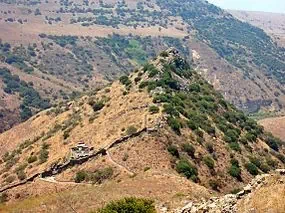History
 Situated at the southern part of the Golan, overlooking the Sea of Galilee, Gamla was built on a steep hill shaped like a camel's hump, from which it derives its name (Gamla meaning 'camel' in Aramaic). The city appears to have been founded as a Seleucid fort during the Syrian Wars (3rd century BCE) which later became a civilian settlement. Jews inhabited it from the last quarter of the 2nd century BCE, and it was annexed to the Hasmonean state under king Alexander Jannaeus in c. 81 BCE.
Situated at the southern part of the Golan, overlooking the Sea of Galilee, Gamla was built on a steep hill shaped like a camel's hump, from which it derives its name (Gamla meaning 'camel' in Aramaic). The city appears to have been founded as a Seleucid fort during the Syrian Wars (3rd century BCE) which later became a civilian settlement. Jews inhabited it from the last quarter of the 2nd century BCE, and it was annexed to the Hasmonean state under king Alexander Jannaeus in c. 81 BCE.Josephus Flavius, Commander of Galilee during the Jewish Revolt against Rome, in 66 CE fortified Gamla as his main stronghold on the Golan. Josephus gives a very detailed topographical description of the city and the steep ravines which precluded the need to build a wall around it. Only along the northern saddle, at the town's eastern extremity, was a 350 meters-long wall built. It was constructed by blocking gaps between existing houses and destroying houses that lay in its way.
Initially loyal to the Romans, Gamla turned rebellious under the influence of refugees from other locations. It was one of only five cities in the Galilee and Golan who stood against Vespasian's legions, reflecting the cooperation between the local population and the rebels. At the time of the revolt, the town minted its own coins, probably more as a means of propaganda than as currency. Bearing the inscription "For the redemption of Jerusalem the H(oly)" in a mixture of paleo-Hebrew (biblical) and Aramaic, only 6 of these coins have ever been found.
 Josephus also provides a detailed description of the Roman siege and conquest of Gamla in 67 CE by components of legions X Fretensis, XV Apollinaris and V Macedonica. The Romans first attempted to take the city by means of a siege ramp, but were repulsed by the defenders. Only on the second attempt did the Romans succeed in breaching the walls at three different locations and invading the city. They then engaged the Jewish defenders in hand-to-hand combat up the steep hill. Fighting in the cramped streets from an inferior position, the Roman soldiers attempted to defend themselves from the roofs. These subsequently collapsed under the heavy weight, killing many soldiers and forcing a Roman retreat. The legionnaires re-entered the town a few days later, eventually beating Jewish resistance and completing the capture of Gamla.
Josephus also provides a detailed description of the Roman siege and conquest of Gamla in 67 CE by components of legions X Fretensis, XV Apollinaris and V Macedonica. The Romans first attempted to take the city by means of a siege ramp, but were repulsed by the defenders. Only on the second attempt did the Romans succeed in breaching the walls at three different locations and invading the city. They then engaged the Jewish defenders in hand-to-hand combat up the steep hill. Fighting in the cramped streets from an inferior position, the Roman soldiers attempted to defend themselves from the roofs. These subsequently collapsed under the heavy weight, killing many soldiers and forcing a Roman retreat. The legionnaires re-entered the town a few days later, eventually beating Jewish resistance and completing the capture of Gamla.According to Josephus, some 4,000 inhabitants were slaughtered, while 5,000, trying to escape down the steep northern slope, were either trampled to death, fell or perhaps threw themselves down a ravine. These appear to be exaggerated and the number of inhabitants on the eve of the revolt has been estimated at 3,000 - 4,000. The notion that these inhabitants committed mass suicide has also been questioned, as the account appears to force an analogy with the story of the end of the siege of Masada, also recounted by Josephus. The Greek word Josephus used implies a hasty, clumsy flight while suicide is forbidden under most circumstances by Jewish law.
Source: Wikipedia








 Works On Coy
Works On Coy